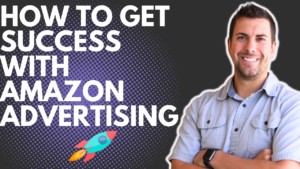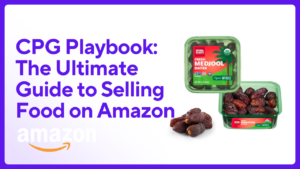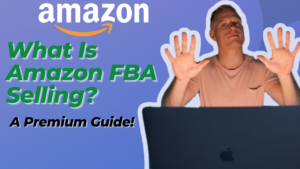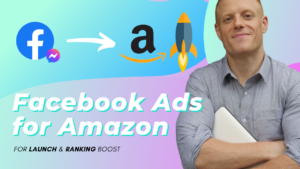I’ve been doing Amazon marketing for 7+ years full-time now and have a deep understanding of how ranking works. This is my ultimate guide on how to rank on page 1 on Amazon!
The great thing about Amazon is there is SO much traffic flowing through it – 200 million people per month in the US alone (that’s MOST of Americans!) – that when you appear on Page 1 for your main keywords, the potential upside is HUGE.
Getting solidified on Page 1 is how many brands do $1,000,000+ per month on Amazon – month in, month out. Once you rank on Page 1 and your product continues to get good reviews, you get ‘locked-in’ there.
Then, it’s like a snowball effect: more sales come in, which leads to more reviews. Which leads to more sales. The upward spiral continues. This is what I call CRUSHING it on Amazon. It’s what makes Amazon a huge opportunity for brands. BUT, Page 1 is prime real estate – every brand is fighting to get there.
So how do you get on Page 1? Well, first you need a great product that customers love. Got that? Ok, let’s move on. Next, you need to understand how the algorithm works, so you can play its tune and give yourself the best possible chance of ranking there.
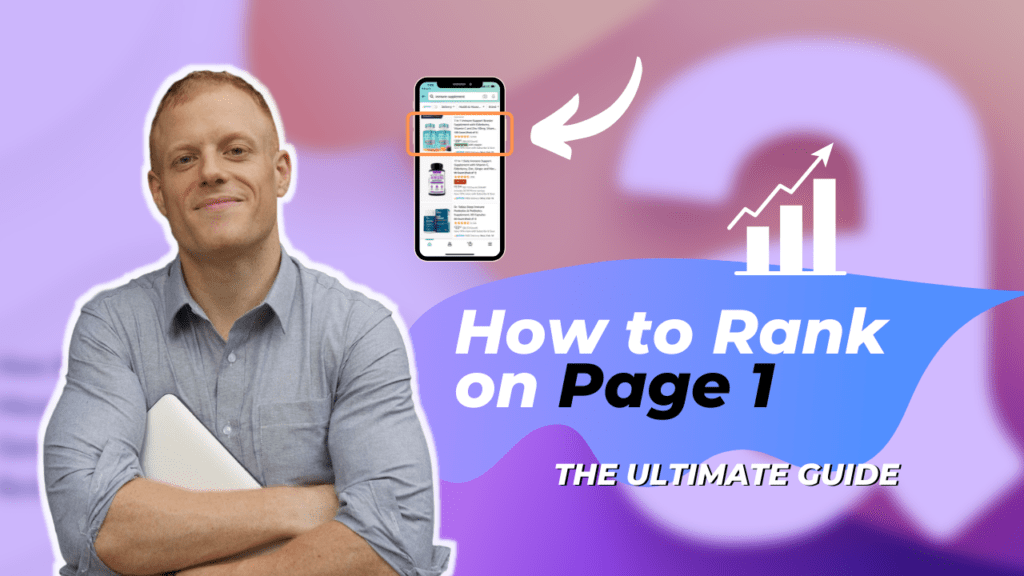
Here’s a video walkthrough – if you prefer to watch me go over this blog post.
How Amazon Ranking Works
Ranking is most heavily based on these 2 key factors:
1. Sales Velocity
This is determined by the total sales in the past 180 days (6 months). The more the better. The average daily sales on Amazon is 36 per day.
2. Conversion Rate
Conversion Rate, or CVR, is a % of shoppers who view your product page that buy – for a specific keyword. The higher the better. Low: 7% or less. Average: 10%. Great: 20%.
These are the 2 big ones, so that’s where the focus should be. But there are some other things that are factored into ranking as well.
Other ranking factors:
- Click-Through Rate (CTR): This is the % of shoppers who see your product in the search results that end up clicking on your product to view the detail page. The average CTR on Amazon is about 0.5%.
- Reviews & Rating: Customer Happiness! Amazon wants its shoppers to be happy – so the more happy reviews a product has, the more people Amazon will recommend it to.
- External Traffic: Amazon likes products that bring visitors to their site. This includes links to Amazon products that are on social media content (or ads), websites, or blogs.
- Seller Rating: Customers can share feedback about on-time shipments, communication, etc. A higher seller rating is good for ranking.
- Prime Fulfilled (FBA): Amazon prefers products that are Prime eligible, e.g. use Amazon’s FBA fulfillment. Because Amazon makes more money, and customers prefer the fast shipping.
- PPC Sales: Amazon is in the business of making money, so it is theorized that the organic ranking algorithm favors products that are spending advertising dollars.
Below is a chart I made showing my theorized weight of how the Amazon ranking algorithm works.
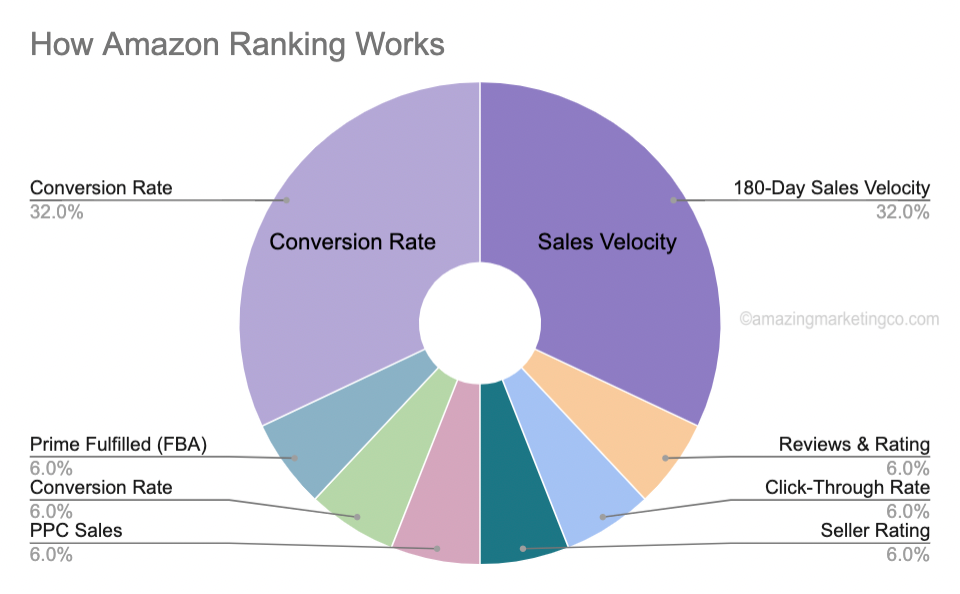
So, in order to rank high need we need to have …
- High Sales
- High Conversion Rate
The shopping flow:  Impressions (awareness) > Clicks (interest) > Sales (decision)
Impressions (awareness) > Clicks (interest) > Sales (decision)
But here comes the chicken & egg problem… how do you rank a new product if there is no sales history!?
In short: promotions & advertising!
How to Boost Sales Velocity
In order to get sales, first, you need impressions (people need to be aware of your product!). Then clicks, then conversions (sales). Below are breakdowns of the ways you can boost your sales velocity – it comes down to age-old marketing tactics: promotions and advertising!
Amazon PPC Ads (Sponsored Placement)
Amazon Sponsored Placement advertising is a major way to boost sales velocity. Basically, this is paying Amazon extra money (on a pay-per-click basis) to be shown to more shoppers. This can be very effective when used in combined with outside traffic.
How PPC Works
PPC stands for Pay Per Click, meaning that you pay only when your ad is clicked. The cost per click (CPC) is determined by the bid: the highest bidder for that keyword and placement gets their ad displayed.
Types of Amazon Ads
- Sponsored Products
- This is the most common form of Amazon ad. It places individual products in ‘Sponsored’ sections around the Amazon site – most typically in search results – either top, middle or bottom of the page. ‘Top of search’ clicks cost more (but luckily there ar some tricks to optimize this:).

- Sponsored Brands
- This is where you can place ads on competitor listings. When done correctly, this can be very effective at getting sales!

- Sponsored Display
- This is where you can place ads on competitor listings. When done correctly, this can be very effective at getting sales!

- Sponsored Coupons
- You can now advertise coupons for your products at different locations around Amazon.

- Sponsored Video
- This is the newest most exciting form of Amazon ad – you can place a video advertisement smack dab in the middle of Page 1 search results. These have been performing very well for my products and my client’s products!

Best Practices
- Turn on PPC ads after 2 reviews: because shoppers typically don’t buy products with 0 or 1 reviews.
- Basic PPC campaign setup for launch: Turn on 1 Automatic campaign, 1 Manual campaign focused on your main target keywords, and 1 Manual campaign with keywords that have your brand name in it (because you want these stats to be kept separate).
- Starting budget: we usually start out with a daily budget of $50 or $100 per parent ASIN, depending on how aggressive you want to be.
Tips & Tricks
- Use PPC software to help you set up, monitor & automate campaigns. We use Sellozo because it is highly customizable.
- Hire an expert or agency to monitor & manage ad campaigns for you. Like any marketing campaign, it takes TLC to get right.
Ongoing Optimization: There could be an entire course on Amazon PPC optimization (we are creating one:), but for now you can check out our 5-Step PPC Optimization Checklist, which breaks down these 5 things that you should be doing right away to optimize spend & sales.
- Add Negative Keywords
- Optimize Placements
- Isolate Search Terms
- Analyze Competitor Keywords
- Use Brand Protection Campaigns
Check out this tutorial video on how Ryan sets up PPC campaigns for a product launch:
Average PPC stats
- Average ACOS: 28%
- Average Ad Conversion Rate: 9.5
- Average CPC (Cost per click): $0.71
- Average daily adspend: $268
Giveaways
Since ranking is heavily based on how fast a product is selling, how to we boost our sales velocity? Well, savvy Amazon sellers have been using various tactics for years to boost their sales velocity. The main way involves some sort of a giveaway – and the best way to do this is via rebate because you get a full-price sale on Amazon.
Rebate sites aka ‘Deal sites’
Companies have been using rebates for ages as a way of promoting new products. It involves offering some or all of the money back after a customer makes a purchase. In the past companies would often send out coupons in the mail for rebate offers. Today, savvy Amazon sellers offer big rebates on their products in order to boost Amazon sales velocity.
In recent years, Amazon rebate sites or ‘deal sites’ have popped up around the internet. These sites allow shoppers to claim big rebates for products on Amazon. Sellers love them to boost sales velocity, and shoppers love them to get killer deals!
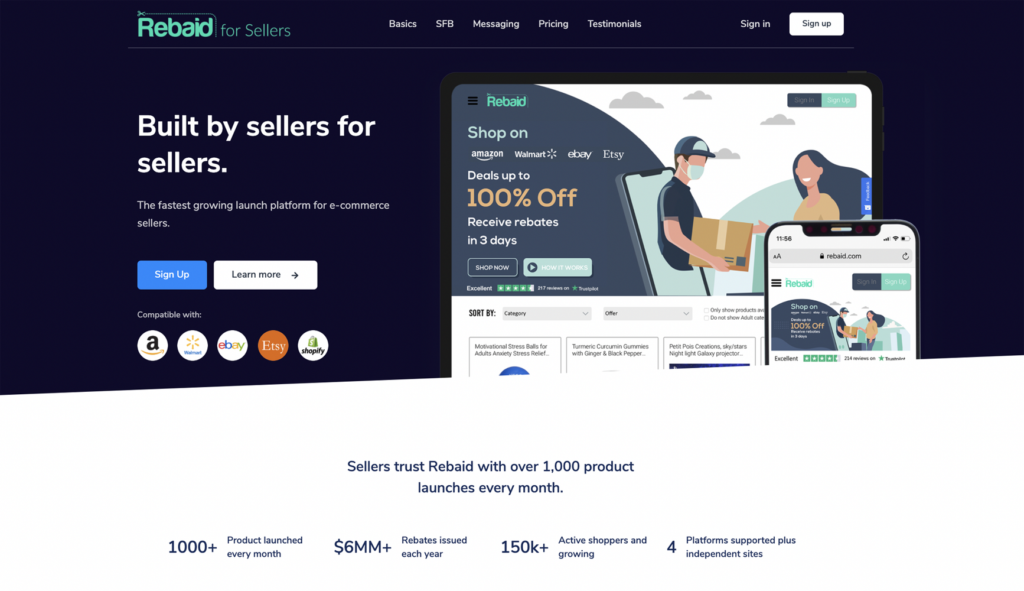
Rebaid.com: The site we use is Rebaid.com. I think it’s the best site. They only charge a small $3 fee per giveaway, and it’s easy to use. I even had the founder on my podcast in this episode and he offered the listeners the first campaign free via this link.
Do rebate sites help with reviews? To clarify, rebate sites are NOT used for reviews – they are used for RANKING (boosting sales velocity). This being said, review rates for rebate sites are a bit higher than normal. For Rebaid, their CEO said the average review rate is about 10% normally, or about 15% if you use their SMS follow-up system, compared to the 3-4% average.
Facebook & Instagram Ads (via ManyChat)
The other main way savvy Amazon sellers offer rebates is via Facebook/Instagram ads. It involves putting out an ad offering a big rebate on Amazon. E.g. “90% OFF after Rebate! Today only on Amazon!”

The ad takes the shopper to a landing page or messenger bot that captures their email and details instructions on how to order the product on Amazon and claim the rebate. The most common way to distribute rebates is via PayPal or Amazon gift card. We use a tool that automates the distribution of rebates called Rebate Automation by Seller Tools.

Here’s a breakdown of how we do it:
Step 1: Run Facebook & Instagram Ad
- The ad will be promoting a ‘Launch Special! FREE After Rebate!’ deal for a product on Amazon.
- It targets people who are interested in the product or niche.
- The ad can be a video, image, carousel, or slideshow
- The ad will be promoting a big discount – via rebate. The higher the discount, the more orders you will get. 80-100% off is recommended (this is what your competitors are doing!)
Step 2: ManyChat Flow
- Once people click on the ad, they are taken to Facebook Messenger, and the custom flow handles the rest!
- To continue to your Amazon listing, they need to click a ‘Buy Now’ button in ManyChat – this is to prove that they are serious buyers, which drives the conversion rate VERY high on your listing, leading to a powerful ranking boost.
Step 3: Shopper Orders on Amazon
- The shopper buys your product for full-price on Amazon.
Step 4: Organic Ranking Goes Up
- Because your listing is now converting at a higher rate
- Because Amazon loves that you brought outside traffic to their website
Step 5: Upward Spiral of Sales
- Since your organic ranking is now higher (likely on page 1), you will start to get LOTS more organic sales!
- If organic Amazon traffic converts at a good conversion rate (15%+), your organic ranking will stay high, leading to a higher sales velocity long-term.
- The mission is to rank on page 1 for your main keywords (this is where the big $$$ is at!). We will keep trying until you are there!

Promote to Your Audience
Email List
For an Amazon launch, you want a steady stream of sales, not one big blast. So it’s best to segment your audience and send out emails in batches. You can do this using your email marketing software (we use ActiveCampaign).
Social Media Following
Best Practices
Tips & Tricks
Add “Check Out on Amazon” to your Website

How to Boost Conversion Rate
Having a great conversion rate is a HUGE part of ranking highly on Amazon. Remember, Amazon wants to show the products that make them the most money!
So, how do we ensure that shoppers visiting our product listings are BUYING at the MAXIMUM POSSIBLE rate? Well, it comes down to what they see on the listing! Making a listing the best it can be is what we refer to as “Listing Optimization!”.
Listing Optimization
The following fall into the listing optimization category. The main pieces of a product listing (also known as a product detail page) are the images, the A+ content, and the copywriting.
Gallery Images
Everyone knows that images are huge. The images are the first thing that shoppers look at. So it’s imperative that EVERY image is as good as possible! The goal of the images is to showcase the product in the most beautiful and appealing way possible – to let the shopper see the quality of the materials, the features & benefits, while selling them on why you are the RIGHT choice.
Best Practices
- Make all mages be at least 1000px on the shortest size so they will be zoomable.
- This is important so shoppers can see the product material up close.This is important so shoppers can see the product material up close.
- The bigger the image size, the further in the zoom will be.
- Use a professional camera with good lighting
- Use photoshop or other editing software to remove spots and glare
- An infographic is a graphic that contains info – often via using text, icons & charts.
- Types of infographics
- Feature callouts: highlight and explain features.
- Comparison charts: compare features & benefits with the competition.
- Helpful info: Share helpful info about the product, how it’s used, or general helpful tips about your niche that would benefit your target customer.
- Demonstration/Instructional: explain and show how the product is used.
- Show the product in action ‘in real life’.
- This can be an actual photoshoot, or using photoshop.
Tips & Tricks
- I make my images 3000px on the longest side, which is the biggest size allowed. This allows shoppers to zoom in as close as possible.
- I make my gallery images ‘portrait’ – 4:3 ratio. This basically fills more of the screen when viewed on mobile.

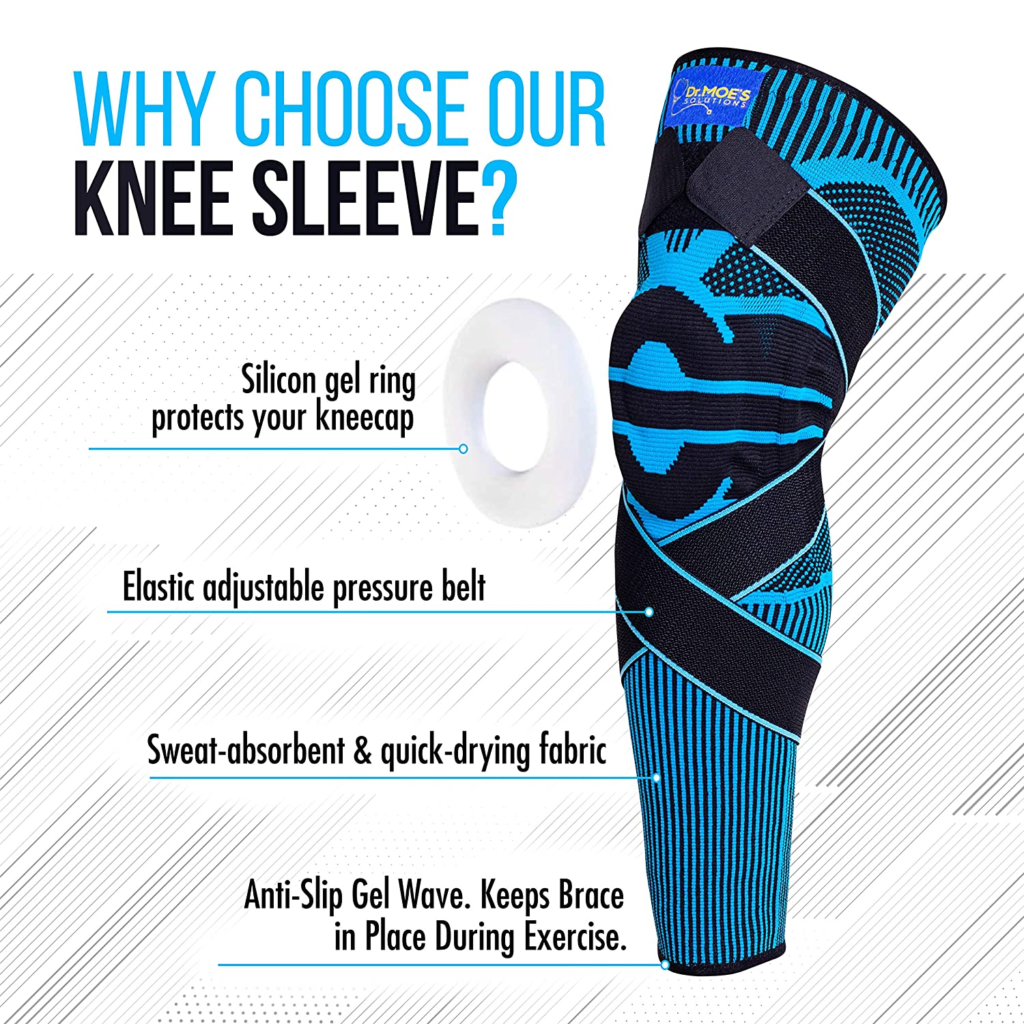
A+ Content
Launched in recent years and formerly known as EBC or Enhanced Brand Content, the A+ Content is basically a section on the product detail page that contains more images and text. This is typically what shoppers look at after checking out the gallery images – so it’s a great place to showcase even more info about your product while hammering home why they should buy. It’s the place to “lock in the sale”. Keep in mind, you must be Brand Registered.
Best Practices:
Tips & Tricks
Amazon’s official A+ Content Guidelines.


Copywriting
Copywriting is the art of communicating efficiently & effectively via text – usually referred to in a ‘selling’ context. In an Amazon context, copywriting refers to 3 main facets:
- Explaining / showcasing the product
- Selling / convincing shoppers to buy
So, a professional Amazon copywriter is a master at choosing the best & most relevant keywords/search terms (Amazon SEO) and explaining the product as concisely as possible, all while convincing the shopper that it’s the right choice for them and to BUY now.
Best Practices, Tips & Tricks
- Title:
- Make it as easy to read.
- Describe the product as consicely as possible
- Make it stand out: look at your competitor’s title’s and try to make yours capture attention
- Bullet points:
- While many Amazon sellers like to fill up the full 250 characters for each bullet, I like to keep them short & sweet.
- Amazon is moving away from allowing ALL CAPITAL LETTERS in the bullets.
- 𝙃𝙤𝙬 𝙩𝙤 𝙪𝙨𝙚 𝙗𝙤𝙡𝙙 𝙛𝙤𝙣𝙩 𝙡𝙞𝙠𝙚 𝙩𝙝𝙞𝙨: Go to a Metafont generator and type in what you want, then paste it into the bullets. This is grey-hat, so don’t be surprised if it gets blocked eventually.
- Focus on benefits over features.
- Focus on benefits over features.
- Description
- Use numbered lists, bullet points, bold, and spacing. You can do this by using an HTML editor.
- Include your obvious keywords, but no need to keyword stuff here.
Keywords / SEO
Amazon is a keyword-based shopping platform. That is, shoppers type in keywords (also referred to as ‘search terms’ or ‘keyphrases’) to find things. The words that are on our product listing tell Amazon what our product is – via the title, bullet points, description and backend. So, it’s important that we put the best and most relevant keywords on our listings.
- Title:
- The title takes 1st priority in SEO: all text in the title gets indexed, so make sure you have your most important keyphrases & words here.
- Put your focus keyphrase first. Sellers have found this can help with ranking.
- There’s no need to repeat words or keyphrases.
- Bullet points:
- The bullets take 2nd priority in SEO: the first 250 characters get indexed (for most categories).
- Include your main keyphrases in the first 2 bullets, along with some tier II keywords.
- Keyword research:
- Use a keyword research tool to determine which words & search terms to put in your title, bullets, backend & description / A+ content. I like Jungle Scout the best for this.
- A+ Content / description:
- Include your obvious keywords. Before publishing the A+ Content, publish the description first because it is believed this helps with indexing.
- Use text boxes in the A+ Content (as opposed to images only) as this helps with indexing on Amazon as well as Google.
- Backend:
- The backend keywords section takes 3rd priority. This is the tab in the Edit Product section where it allows you to enter up to 250 characters in the Search Terms box (and more for some categories). It is best practice to enter any words/phrases that are not yet included in the title or bullets.
Use Videos
Use videos on your listings! Many categories allow 2 or more videos in the image gallery. Also put videos in the Videos section (formerly Related Video Shorts)
Best Practices, Tips & Tricks
- I like to have 1 short video – a ‘commercial’ that quickly explains & sells the product. Think around 30-90 seconds.
- Also, 1 longer video – a combination of these things. It can be up to 10-minutes for many categories.
- Unboxing
- Customer review/testimonial
- How-to
- Message from the owner
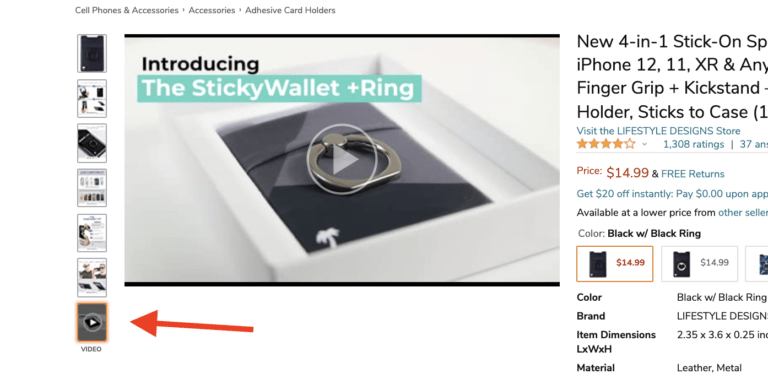
- Videos section
- You can upload as many videos here as you like! Just click Upload Video on the listing!
- This is a great place to add ALL types of videos mentioned above!
- Customer video reviews also show here (tip: ask a few people to do video reviews!)
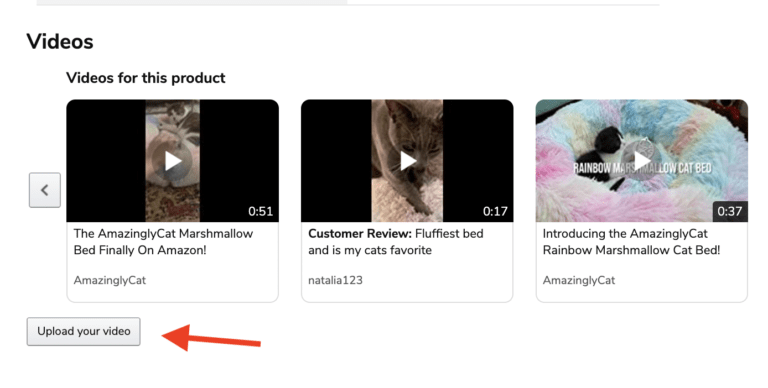
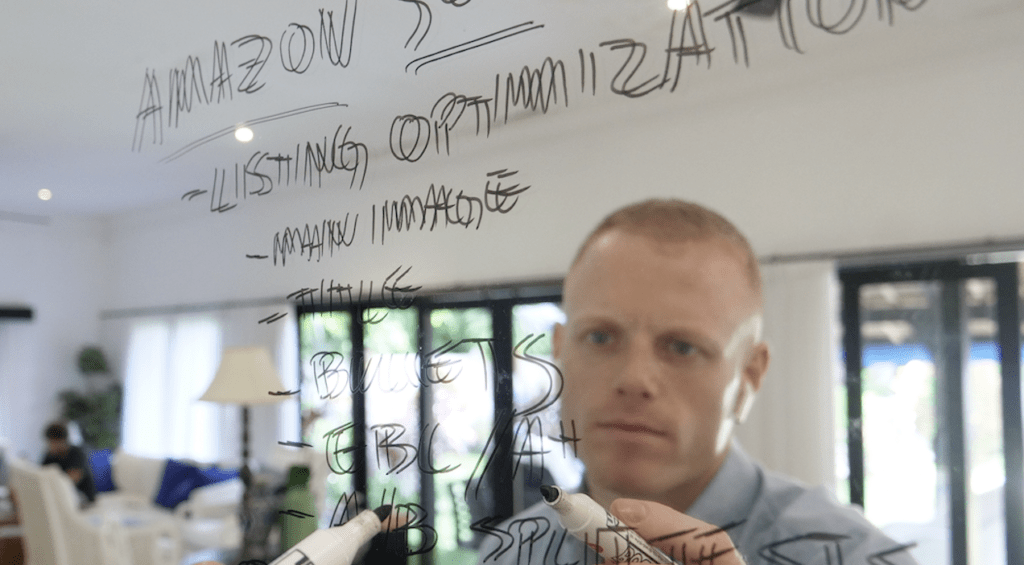
How to Boost Click-Through Rate (CTR)
Clickthrough rate or CTR is the % of shoppers that click on your product when they see it browsing. A 10% CTR means that 10% of shoppers according to best Amazon Agency who see your listing in search results end up clicking on it at some point while shopping.
So how do we increase CTR? Well, these are the things that a shopper can see while browsing…
- Main image
- Product title
- Sale price
- Review count & Rating
- Coupons
So, we must optimize these things to entice shoppers to click! Let’s go over these things and some best practices, tips & tricks.according
Main Image
The main image, also known as the ‘hero image’ is the first image that a shopper sees. It is vitally important, and tricky to get right. The goal of the main image is to capture attention while trying to convey what the product is, the quality of it, its USPs, and its functions – all in one image.
Best Practices
- High quality photo
- White background
- Show accessories
- Highlight any unique features where possible
- Make the product fill up as much of the image as possible
- There are other rules to follow: read Amazon’s main image requirements.
Tips & Tricks
- Instead of a head-on photo, a 15-degree downward-facing camera angle works best for many products.
- Shoot all accessories and/or separate pieces separately, and edit them into 1 image later.
- The below are a few things sellers to in their main images. They may or may not be officially allowed in TOS, but many sellers do these things anyway.

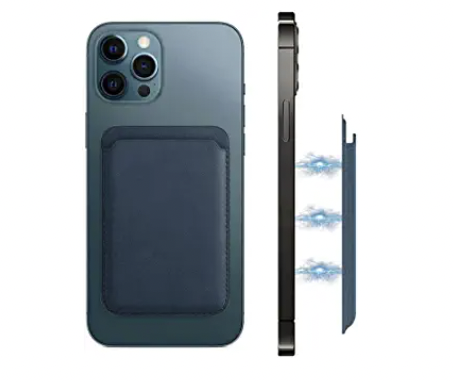

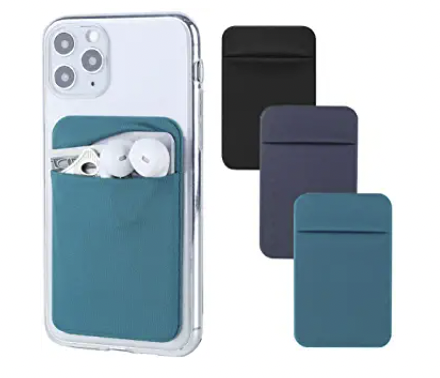
Product Title
- Instead of a head-on photo, a 15-degree downward-facing camera angle works best for many products.
- Shoot all accessories and/or separate pieces separately, and edit them into 1 image later.
- The below are a few things sellers to in their main images. They may or may not be officially allowed in TOS, but many sellers do these things anyway.
Best Practices
- Make it easy to read: I like to use long dashes ‘–’ or plus signs ‘+’ to space out words/features/benefits
- Make the features & benefits as clear & concise as possible
Tips & Tricks
- Put your main keyword first
- E.g. “Stick-on Phone Wallet – The StickyWallet by Lifestyle Designs …”

- This is a title I wrote for my product.

- This is a bad title. It's not natural to read. You can tell they just listed a bunch of keywords..
Sale Price
Shoppers on Amazon tend to be pretty savvy when it comes to comparing different options – so the price is definitely a big factor in their decision-making process! Of course, the more unique your product is, the more you can charge! But in general, a LOWER price means a HIGHER click-through rate! So basically, the more competitive the price compared to similar products on the page, the more people will click on it!
Best Practices
- Always have a Sale price.
- In the Edit Product backend, enter a Price which is the ‘regular price’ (this will be displayed as the crossed-out in many categories), and a Sale price, which is what the shopper actually pays.
- Keep the price low during the first 6-12 months to build sales velocity & ranking juice.
- Do competitor / market research and price your product competitively
Tips & Tricks
- How to get the red badge: ‘Lowest Price in 30-Days.”
- Raise & lower the price every 30 days: from your regular ‘sale price’ to a ‘lower sale price’. This should display the red badge in theory – however, it’s a new feature and sellers aren’t quite sure exactly how it works. It seems to work in only some product categories.
- Price your product at least $1.00 lower than your direct competitor, especially during the first 6-12 months or while you’re trying to boost ranking.
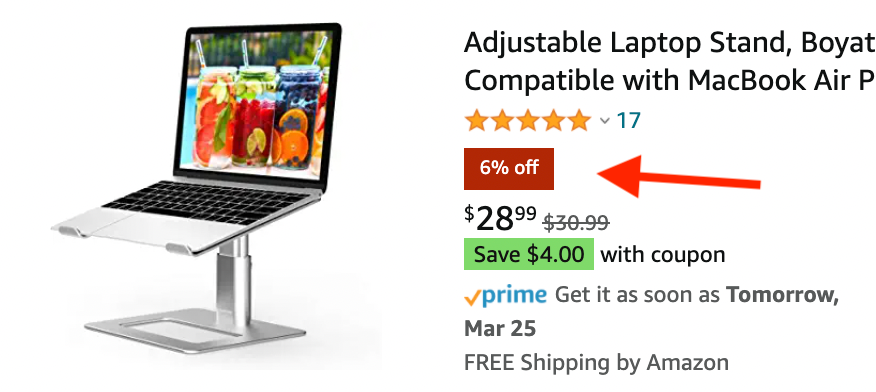

Coupons
Clippable coupons are a relatively new feature on Amazon that basically offers a small discount for shoppers. Not only does it incentivize shoppers to click & buy because they’re getting a deal, but the green badge catches attention on page results! Simply put, Coupons have shown to boost CVR.
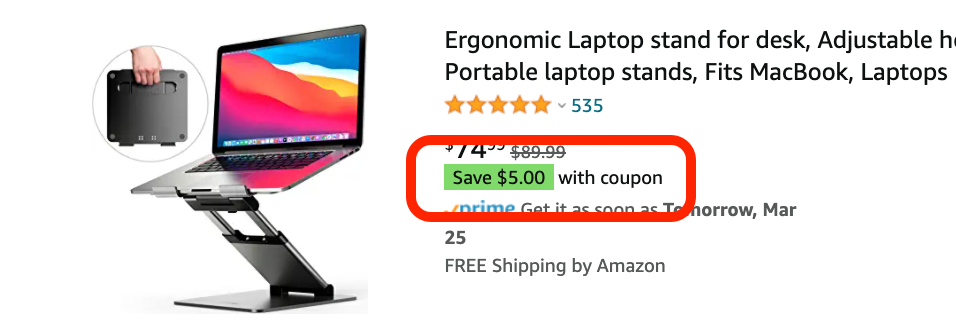
Best Practices
- Keep coupons on for all of your products
- Keep coupons on for all of your products
- A/B split-test your coupons
- E.g. $2.00 OFF vs 20% OFF vs NO coupon
- This will help you determine the most profitable offer for the long-term, making you $1,000’s in extra profits.
Amazon charges a $0.60 fee per coupon clipped, so be sure to factor that into your profitability calculations.
Tips & Tricks
- Turn off coupons when running giveaway/rebate campaigns. Because you don’t want to pay the 60 cents fee and because the rebate amount that you pay doesn’t factor in the coupon discount.
- Advertise your coupons
- This is a relatively new feature. It’s a new form of Sponsored PPC Ad that you can turn on inside the Advertising Console.
Other Ranking Factors
Reviews & Rating
This is self-explanatory. The higher the product rating and # of positive reviews, the more Amazon will want to show your product. Ultimately, a better rating and more reviews leads to a higher CVR. I’ve found that having 4-stars or above to be crucial. I’ve noticed that when my products drop from 4 to 3.5 stars, sales can drop 20-30%!
Best Practices
- Have a solid product that doesn’t break
- Focus on getting your first 30 reviews ASAP. We use fbareviews.com to get our first batch of reviews for new products.
Tips & Tricks
- List
- How to keep reviews coming in at a high rate:
- Use product inserts. There is a tool that we use called getreviews.ai that automates this process.
- Turn on review-request automation in Jungle Scout. This is a tool that automates Amazon’s new ‘Request Review’ function. See my how-to video here.
- Email follow-ups: Amazon is moving away from this. Read my article here.
- The average review rate is 1-2%. But with an effective follow-up strategy you can get it to 3-5%. My products average around 4% by using the above.
Questions & Answers
There is a section on each detail page where shoppers and customers can ask questions. More questions answered means an easier purchasing decision for the shopper, which leads to higher CVR. You should get an email from Amazon every time a customer posts a question. Answer them asap!
Seller Feedback
Customers can leave Seller Feedback, which is a rating & review for the experience with the seller. They can share feedback about on-time shipments, communication, etc. A higher seller rating is good for ranking.
Page Completeness
Make sure all tabs in the backend are completely filled out, including tech specs. Amazon wants to show products that contain all the necessary info.
In-Stock Rate
Amazon doesn’t prefer to show products that frequently run out of stock! Stay in stock! This is a big part of success on Amazon – simply staying in stock.
Tips & Tricks
The dual FBA-FBM rule:
-
- If you are FBA, create a duplicate ASIN that is FBM (it will have a new SKU). This is easy to do: Add Product > type in the ASIN > select FBM (Fulfilled by Merchant).
- Savvy Amazon sellers do this so in case FBA goes OOS (out of stock), then sales will automatically go to the Merchant Fulfilled (FBM) SKU.
- Of course, make sure you have inventory in-stock ready to fulfill via a 3PL. Or worst case, inventory at your office that you can ship out yourself daily until FBA is back in stock. If you need a 3PL, we recommend Deliverr.

- Proper inventory planning
- The most important thing is proper inventory planning!
Return Rate
If your return rate is above 5% it will kill your rank. If it creeps to 8%, Amazon will suspend your listing and ask you to submit a plan to correct the issues. Along with every return, customers select a reason and write why they are returning the item, so you will know why people are returning.
Tips & Tricks
- The Product Insert Trick
- Savvy sellers do this to return rate. On your product insert or packaging, make it known that they should contact you for returns. When they do, just let them know that you went ahead and refunded their order – do this in Seller Central by clicking the Order # > Refund – because this isn’t as bad for ranking as a return. You can optionally instruct them to return it to your office, or just tell them to keep it. For example, write something like:
- Need to Return? Email us at ___ for instructions.
- We handle returns! Email us at ___ for instructions.
- Listen to customers: improve the product & fix issues.
- Sell a Quality Product!
On-Time Shipments
If you are Merchant Fulfilled (FBM), make sure your shipments are always on time! If your late shipment rate reaches 4%, your listing will be suspended! So make sure you use a fulfillment solution that is always on time! Ideally, they can do 1-2 day delivery nation-wide. If shipping time is 3 days or longer, many shoppers will reconsider.
Bonus Tips!
Editorial Recommendations
If only there was a way to contact editorials to make them aware of your product to review it, and potentially get it featured in one of their ‘Editorial recommendations’ articles, which are displayed in Amazon search results (typically page 1). Well, I’ve managed to get my products there! There’s no exact science, but feel free to get in touch for details on how we did it. Of course, your product must have a lot of reviews and 4+ rating.
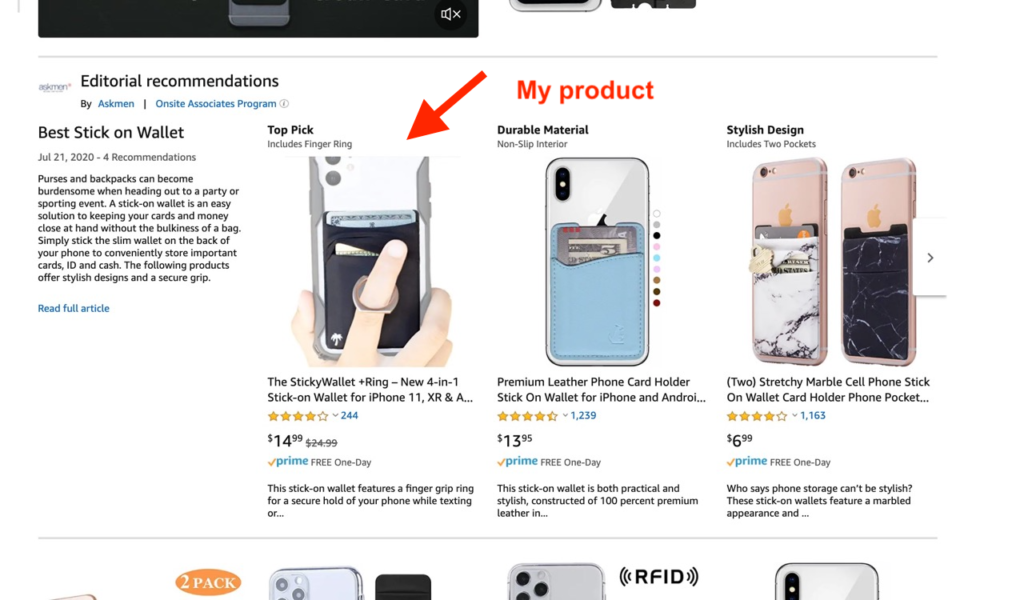
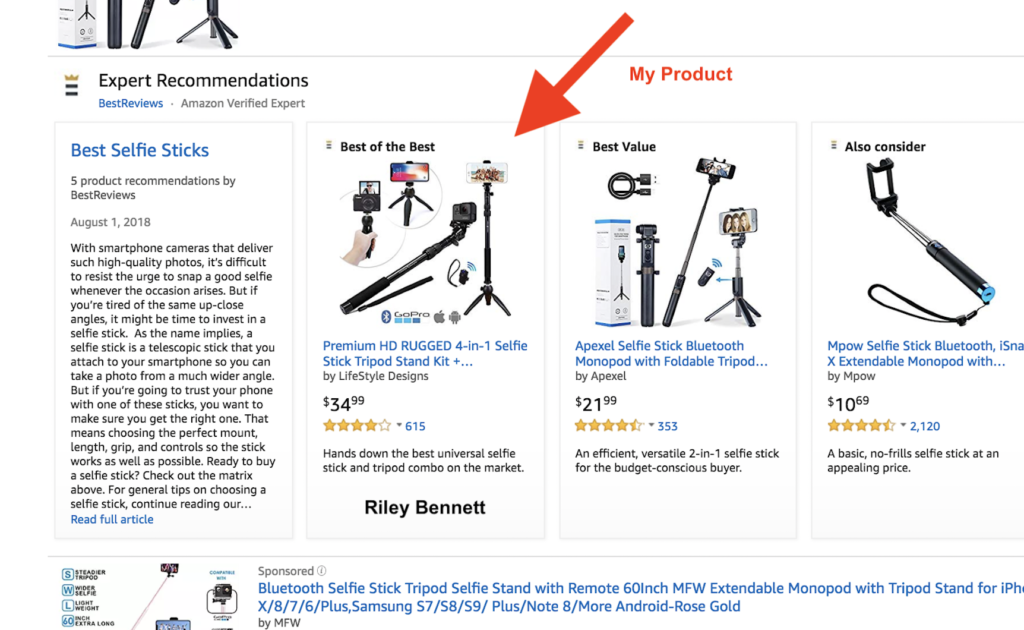
Virtual Bundles
This is a new feature that allows you to combine separate products into one ‘bundle’ offer. They appear right above the Frequently Bought Together section. Set up virtual bundles on your bestselling products to boost sales for your other products. Read my virtual bundles post for more details!
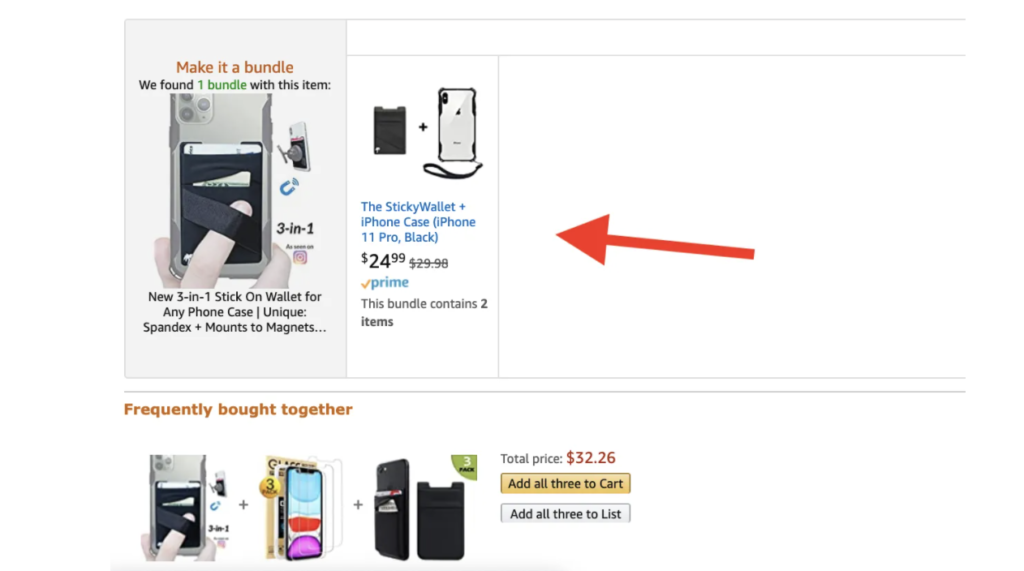
How to Track your Ranking
Best Seller Rank
Amazon essentially ranks all products in each category and gives them a score called Best Seller Rank (or BSR). It’s a score of where each product ranks overall in the algorithm’s eyes compared to other products. A BSR of 10,000 is higher ranked than 40,000, for example.
Where to see your Ranking
I use the Keyword Ranking Tracker in Jungle Scout – it’s a great way to track on how organic ranking fluctuates for all of my client’s target keywords over time. You can also quickly see where any product ranks organically by pasting the ASIN into Keyword Scout.
Product Launch Strategy
OK, let’s round it out with an example of what we do for a product launch. Assuming you’ve already taken care of listing optimization, the first order of operations is to get your FIRST REVIEWS. To do this, we use FBAreviews.com, Amazon’s Early Reviewer Program, and Amazon’s Vine program. Start this process ASAP so as soon as products are in stock, reviewers can order.
Once 2 reviews are live, we activate Amazon PPC, giveaways via Rebaid.com, and activate Facebook & Instagram ad campaigns using ManyChat. All methods should be targeting the same keyword. Choose a medium to large volume keyword.
All 4 of these things combined, when done correctly, produces the most powerful ranking strategy for the target keyword that I’ve seen. The more sales that come in, the higher you will rank.
A note on Sale Price:
Have an Aggressive Launch Sale Price: It is best practice to launch your product at an aggressive sale price – I call this a ‘launch sale price’. I recommend keeping it priced 10-30% lower than what you’d normally price it at, for the first 6-12 months, to build up as much sales velocity as possible. Simply because the lower the price, the more sales you will get! Many savvy Amazon price their product at ‘break even’ during launch phase.
For example: if your typical ‘on-sale’ price is $26.99′, I’d launch it at about 20-30% lower at $18.99-$21.99 for the first 6-12 months. After that, it is best practice to slowly raise the price $1 back to your target price. Of course, take note of your competitors prices – beat them by at least $1.00 where possible!
Below is the launch timeline that we use for clients. As soon as the listing is optimized and product is in-stock, the launch party begins! The first order of operations is getting REVIEWS as fast as possible! Then once 2 reviews are in, we activate Amazon PPC, giveaways on Rebaid.com, and Facebook & Instagram Ads! From there, it’s all about monitoring and making adjustments & optimizations!

Is it expensive to rank on Page 1
Think of Page 1 as prime boardwalk beachfront real estate in Miami. If you wanted to open a shoe store there, you’d have to invest millions of dollars for the location! So for the first number of years, you may be in the red. But, it’s a good investment because you know the massive amount of traffic will make it profitable long-term!
Same goes with Page 1! It takes a big upfront investment to pay the marketing dollars in the form of Amazon ads, giveaways, and social media ads to get there.
But you’re a smart marketer and you know that by solidifying yourself on Page 1, the massive amount of views will make it a profitable investment – and MUCH sooner than a brick and mortar store or traditional startup (which often stay in the red for the first 5-10 years).
By investing in ‘Page 1 real estate’, many brands are already cashflowing in the green within 1-2 years!
Example launch budget: Month 1
For a $30 product.
Amazon PPC:
- Spend: $3,000 (paid $100/day)
- Payout from sales: ~$1,000.
- True cost Breakdown: Let’s say it’s a competitive niche and you average 200% ACOS (this is high but not unusual for launches in competitive niches – and in fact a good target ACOS for an aggressive launch). This means you made $1,500 in sales with $3,000 in adspend, which gets you a ~$1,000 payout from Amazon after its ~30% cut.
- True cost estimate: ~$2,000
Review giveaways: (via FBAreview.com)
- Fee: $750
- $25 fee x 30 giveaways, paid to FBAreviews.com
- Rebate cost: ~$300
- True cost breakdown: $900 paid upfront ($30 rebate x 30 giveaways), but you will receive ~$20 x 30 orders from Amazon: $600 payout from Amazon.
- True cost estimate: ~$1,050
Ranking giveaways: (via Rebaid.com)
- Rebaid’s Fee: $300
- $3 fee x 100 giveaways, paid to Rebaid.com
- Rebate cost: ~$1,000
- True cost breakdown: $3,000 in rebates ($30 rebate x 100 giveaways – paid daily), but you will receive a ~$20 payout x 100 orders from Amazon. So ~$2,000 from Amazon.
- True cost estimate: ~$1,300

Tools we Use
Jungle Scout (30% discount link)
- Review Automation (H10 doesn’t have this currently)
- Keyword Scout
- Keyword Rank Tracker
- Profit Dashboard
- Inventory Management
- Listing Builder
- Similar to Jungle Scout, but some people prefer it. We use both because some people on our team prefer it.
- Automate PPC campaigns
Summary
Takeaways:
- Most sales on Amazon (about 80%) happen on Page 1, so success on the platform is largely predicated on getting your products there for your main keywords. There are many proven tips & tricks you can implement to get your product ranked on Page 1 (but keep in mind, if it’s not a good product, it won’t stick!).
- Amazon wants to reserve Page 1 for the products that it thinks will give the customer the best experience (based on what they searched for), AND make it the most money (e.g. convert the best).
In summary, to rank on Page 1 you need:
-
High sales velocity
-
High conversion rate
To boost conversion rate you should:
- Optimize your listing
- Run giveaway campaigns
- Have a unique product
- Have a competitive price
OK! That is my ultimate guide on how to rank on page 1 on Amazon. Of course, there are tons more details to know, but this is a solid roundup!
Here are more of my free resources to check out if you want to learn more!
- My blog posts
- My agency services
(And of course, if you’d like my agency to handle all of this for you, you can apply to work with us here!)
What are your tips and tricks? Feel free to share in the comments!
Later!
Riley Bennett
Amazing Marketing Co.
Seattle, WA
“We help brands CRUSH it on Amazon.”
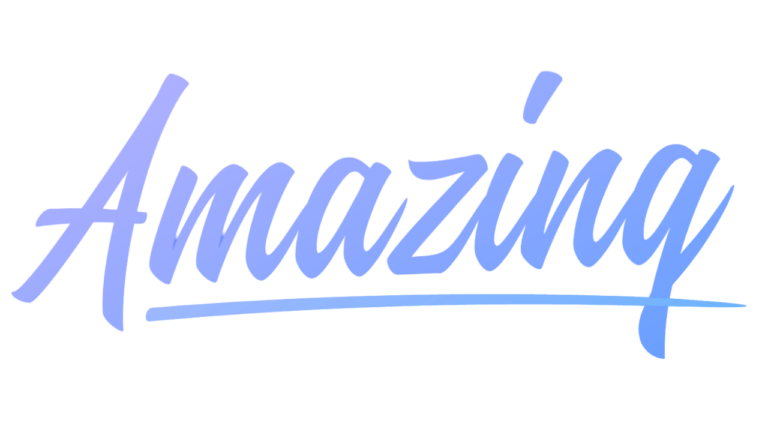

 Impressions (awareness) > Clicks (interest) > Sales (decision)
Impressions (awareness) > Clicks (interest) > Sales (decision)
